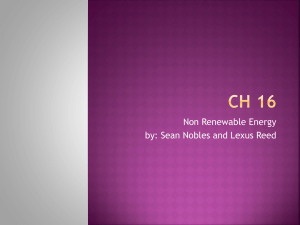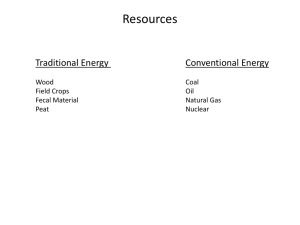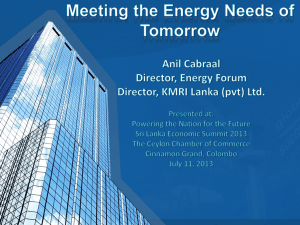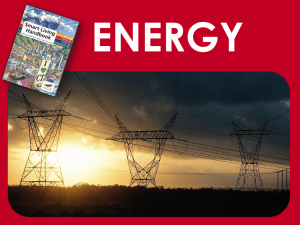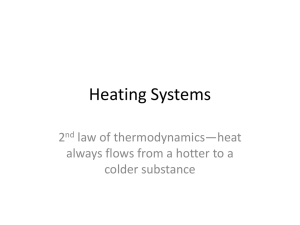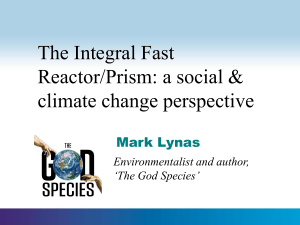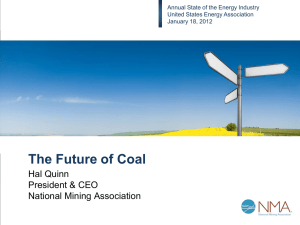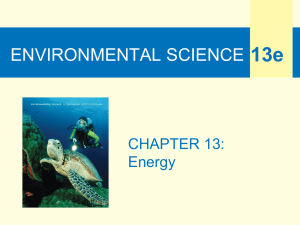chapter15 - Kevinflint.org
advertisement
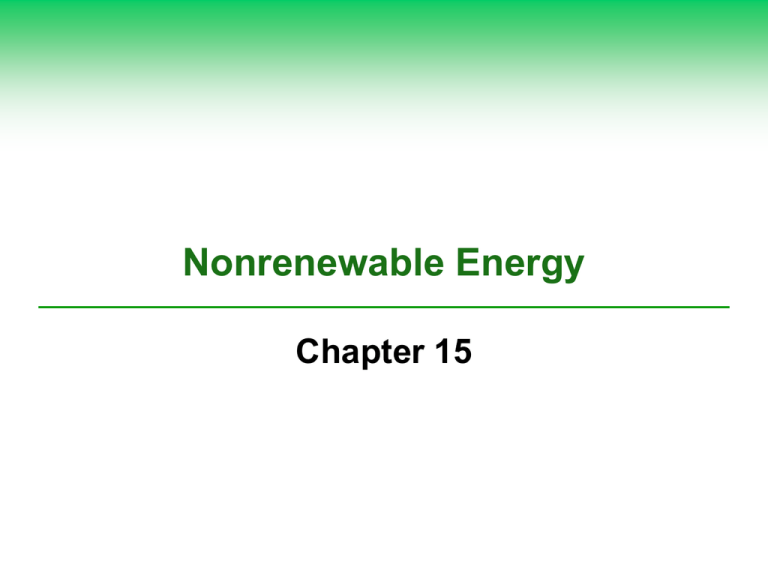
Nonrenewable Energy Chapter 15 15-1 What Major Sources of Energy Do We Use? Concept 15-1A About three-quarters of the world’s commercial energy comes from nonrenewable fossil fuels and the rest comes from nonrenewable nuclear fuel and renewable sources. Concept 15-1B Net energy is the amount of high-quality usable energy available from a resource after the amount of energy needed to make it available is subtracted. How Long Will the Oil Party Last? Saudi Arabia could supply the world with oil for about 10 years. The Alaska’s North Slope could meet the world oil demand for 6 months (U.S.: 3 years). Alaska’s Arctic National Wildlife Refuge would meet the world demand for 1-5 months (U.S.: 7-25 months). How Long Will the Oil Party Last? We have three options: • Look for more oil. • Use or waste less oil. • Use something else. Figure 16-1 Oil projections Natural Capital: Important Nonrenewable Energy Resources Fig 15-2 Commercial Energy Use by Source for the World and the United States Fig 15-3 International Energy information Click for International Energy Agency U.S. historical energy trends Energy flow in U.S. Net Energy Ratios for Various Energy Systems over Their Estimated Lifetimes Fig 15-A 15-2 What Are the Advantages and Disadvantages of Oil? Concept 15-2A Conventional oil is currently abundant, has a high net energy yield, and is relatively inexpensive, but using it causes air and water pollution and releases greenhouse gases to the atmosphere. Concept 15-2B Heavy oils from oil sand and oil shale exist in potentially large supplies but have low net energy yields and higher environmental impacts than conventional oil has. OIL Crude oil (petroleum) is a thick liquid containing hydrocarbons that we extract from underground deposits and separate into products such as gasoline, heating oil and asphalt. • Only 35-50% can be economically recovered from a deposit. • As prices rise, about 10-25% more can be recovered from expensive secondary extraction techniques. • This lowers the net energy yield. General Classification of Nonrenewable Mineral Resources Examples are fossil fuels (coal, oil), metallic minerals (copper, iron), and nonmetallic minerals (sand, gravel). Science: Refining Crude Oil Fig 15-4 What comes from a barrel of oil? OPEC Controls Most of the World’s Oil Supplies Possible effects of steeply rising oil prices • Reduce energy waste • Shift to non-carbon energy sources • Higher prices for products made with petrochemicals • Higher food prices; buy locally-produced food • Airfares higher • Smaller more fuel-efficient vehicles • Upgrade of public transportation Energy in California Foreign Source Crude Oil 2008 Click for Ca Energy Commission OIL Inflation-adjusted price of oil, 1950-2006. What is the cost today? Click U.S. oil supplies Click for EIA data The Amount of Oil That Might Be Found in the ANWR Fig 15-5 Oil in the SBC Click for SB County Click for SB Channel Keepers Gasoline in California Click for animation: ground to car National Gasoline Tax What will motor vehicle fuel cost in the future? Annual Energy Outlook 2008 with Projections to 2030 Source: EIA: http://www.eia.doe.gov/oiaf/aeo/gas.html Trade-Offs: Conventional Oil, Advantages and Disadvantages Fig 15-6 Oil Shale Rock and the Shale Oil Extracted from It Trade-Offs: Heavy Oils from Oil Shale and Oil Sand Fig 15-9 15-3 What Are the Advantages and Disadvantages of Natural Gas? Concept 15-3 Conventional natural gas is more plentiful than oil, has a high net energy yield and a fairly low cost, and has the lowest environmental impact of all fossil fuels. How electricity is made in California How does natural gas get to your home? Click for EIA report NATURAL GAS Russia and Iran have almost half of the world’s reserves of conventional gas, and global reserves should last 62-125 years. Natural gas is versatile and clean-burning fuel, but it releases the greenhouse gases carbon dioxide (when burned) and methane (from leaks) into the troposphere. Liquified Natural Gas Click for EIA report Shale Gas by Hydraulic Fracturing Shale Natural Gas continued • Prices of Natural Gas have dropped: unit = 1000 cubic feet 90s = $2, 2005 = $15, 2010 = $3.50 • Shale Gas reserves increased 50 % from 2007 to 2008 with 30% of this in Texas • Project $4/1000 cubic feet for next 80 years • Low Price Making Wind and Nuke investment slow or stop • Concerns about Groundwater Pollution Shale Natural Gas and Groundwater Many cases of water contamination from shale gas drilling operations, which use high-volume hydraulic fracturing (HVHF), exist: Thousands of problems, including spills, leaks, and the seepage of contaminants into drinking water supplies, have been documented around the country in conjunction with shale gas extraction by HVHF. ► Houses, water wells, and pipelines have exploded, and people have found methane levels in their water so high that they could light it on fire with a match. No studies have demonstrated that gas extraction operations using HVHF do not cause water contamination: In 2010, both the EPA and the House Committee on Energy and Commerce under Senator Waxman initiated major studies on the health and environmental impacts of hydraulic fracturing. Hydrofracking is not an exact science: When gas companies fracture the shale, they do not have complete control over where fractures will develop, so fracturing fluids and natural gas can move in unexpected directions,ending up in aquifers and water wells. Vast numbers of uncapped gas wells threaten aquifers and drinking wells: 18,000 to 48,000 abandoned oil and gas wells that have not been capped exist in NY. During hydrofracking and deepwell injection, the high pressure can force the toxic fluids up through any existing uncapped wells, contaminating aquifers and drinking wells. The process itself is not a problem. We know how to do these things correctly; we know how to do the job right … But there’s a lot of operators who aren’t doing it right.” Ron Nelson, a retired BP Amoco geologist . From Houston Business Journal, Oct 11, 2010. Natural Gas Projections by EIA Trade-Offs: Conventional Natural Gas Fig 15-10 15-4 What Are the Advantages and Disadvantages of Coal? Concept 15-4A Conventional coal is very plentiful and has a high net energy yield and low cost, but it has a very high environmental impact. Concept 15-4B Gaseous and liquid fuels produced from coal could be plentiful, but they have lower net energy yields and higher environmental impacts than conventional coal has. COAL Coal reserves in the United States, Russia, and China could last hundreds to over a thousand years. • The U.S. has 27% of the world’s proven coal reserves, followed by Russia (17%), and China (13%). • In 2005, China and the U.S. accounted for 53% of the global coal consumption. • Burned in 2100 power plants, generates 40% of the world’s electricity Stages in Coal Formation over Millions of Years Fig 15-11 Science: Coal-Burning Power Plant Fig 15-12 Air Pollution from a Coal-Burning Industrial Plant in India Electricity production in U.S. Click of EIA report COAL Coal can be converted into synthetic natural gas (SNG or syngas) and liquid fuels (such as methanol or synthetic gasoline) that burn cleaner than coal. • Costs are high. • Burning them adds more CO2 to the troposphere than burning coal. • Reduces net energy Coal Gasification Click for DOE project info Carbon Dioxide Sequestration Click for DOE info Coal Sequestration Costs To sequester carbon dioxide will cost $25 per ton of carbon dioxide for a combined cycle plant. ($50 per ton of carbon dioxide for a traditional steam powered plant.) This will increase the cost of producing coal 300% to $60 per ton of coal. The power plant that burns the coal to make electricity would face a 50% rise in the cost of producing the electricity. This is around 2 cents/kW-hr. The homeowner buying only coal produced electricity (at 10 Cents/kW-hr) will see a 20% increase (10 cents to 12 cents/kW-hr) in their power bill. These estimates are from Scientific American, pp 52, July 2005 CO2 Emissions Per Unit of Electrical Energy Produced for Energy Sources Fig 15-14 Case Study: Coal Consumption in China Burns more coal than the United States, Europe, and Japan combined Coal–burning plants: Inefficient or non-existent pollution controls Leading area for SO2 pollution: health hazard Acid rain due to coal burning Hg showing up in salmon off the western coast of the United States Air quality of Korea and Japan impacted Trade-Offs: Coal, Advantages and Disadvantages as an Energy Resource Fig 15-15 Trade-Offs: Synthetic Fuels Fig 15-16 15-5 What Are the Advantages and Disadvantages of Nuclear Energy? Concept 15-5 Nuclear power has a low environmental impact and a very low accident risk, but high costs, a low net energy yield, longlived radioactive wastes, vulnerability to sabotage, and the potential for spreading nuclear weapons technology have limited its use. NUCLEAR ENERGY When isotopes of uranium and plutonium undergo controlled nuclear fission, the resulting heat produces steam that spins turbines to generate electricity. • The uranium oxide consists of about 97% nonfissionable uranium-238 and 3% fissionable uranium-235. • The concentration of uranium-235 is increased through an enrichment process. Small amounts of radioactive gases Uranium fuel input (reactor core) Control rods Containment shell Heat Waste heat exchanger Generator Turbine Steam Hot coolant Pump Pump Shielding Pressure vessel Coolant Moderator Coolant passage Periodic removal and storage of radioactive wastes and spent fuel assemblies Pump Pump Hot water output Cool water input Useful electrical energy 25%–30% Waste heat Water Condenser Periodic removal and storage of radioactive liquid wastes Water source (river, lake, ocean) Fig. 15-17, p. 387 After 3 or 4 Years in a Reactor, Spent Fuel Rods Are Removed and Stored in Water What Is the Nuclear Fuel Cycle? Mine the uranium Process the uranium to make the fuel Use it in the reactor Safely store the radioactive waste Decommission the reactor Decommissioning of reactor Fuel assemblies Enrichment Fuel fabrication of UF6 Reactor (conversion of enriched UF6 to UO to UO2 and fabrication of fuel assemblies) Conversion of U3O8 to UF6 Uranium-235 as UF6 Plutonium-239 as PuO2 Temporary storage of spent fuel assemblies underwater or in dry casks Spent fuel reprocessing Low-level radiation with long half-life Open fuel cycle today Recycling of nuclear fuel Geologic disposal of moderate- and high-level radioactive wastes Fig. 15-19, p. 389 What Happened to Nuclear Power? Slowest-growing energy source and expected to decline more Why? • • • • • • Economics: construction & operation costs Poor management Low net yield of energy of the nuclear fuel cycle Safety concerns Need for greater government subsidies Concerns of transporting uranium Case Study: Worst Nuclear Power Plant Accident in the World Chernobyl • April 26, 1986 • In Chernobyl, Ukraine • Series of explosions caused the roof of a reactor building to blow off • Partial meltdown and fire for 10 days • Huge radioactive cloud spread over many countries and eventually the world • 350,000 people left their homes • Effects on human health, water supply, and agriculture TRADE-OFFS Conventional Nuclear Fuel Cycle Advantages Disadvantages Large fuel supply Cannot compete economically without huge government subsidies Low net energy yield High environmental impact (with major accidents) Low environmental impact (without accidents) Emits 1/6 as much CO2 as coal Moderate land disruption and water pollution (without accidents) Environmental costs not included in market price Moderate land use No widely acceptable solution for long-term storage of radioactive wastes Low risk of accidents because of multiple safety systems (except for Chernobyl-type reactors) Risk of catastrophic accidents Subject to terrorist attacks Spreads knowledge and technology for building nuclear weapons Fig. 15-21, p. 391 TRADE-OFFS Coal vs. Nuclear Coal Nuclear Ample supply Ample supply of uranium High net energy yield Very high air pollution High CO2 emissions High land disruption from surface mining Low net energy yield Low air pollution Low CO2 emissions Much lower land disruption from surface mining High land use Moderate land use Low cost (with huge subsidies) High cost (even with huge subsidies) Fig. 15-22, p. 392 Will Nuclear Fusion Save Us? “Nuclear fusion is the power of the future and always will be” Still in the laboratory phase after 50 years of research and $34 billion dollars 2006: U.S., China, Russia, Japan, South Korea, and European Union • Will build a large-scale experimental nuclear fusion reactor by 2040 New and Safer Reactors Pebble bed modular reactor (PBMR) are smaller reactors that minimize the chances of runaway chain reactions. Click for MIT Science Focus: Are New and Safer Nuclear Reactors the Answer? New Generation nuclear reactors must satisfy these five criteria • • • • Safe-runaway chain reaction is impossible Fuel can not be used for nuclear weapons Easily disposed of fuel Nuclear fuel cycle must generate a higher net energy yield than other alternative fuels, without huge government subsidies • Emit fewer greenhouse gases than other fuels Future Energy Projections of U.S. Click for projection report

